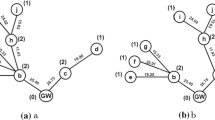Abstract
LoRa technology provides low power, long range and low data rate communication solution for sensor nodes on Internet of the Things (IoT) applications. In this work, we study experimentally the performance of LoRa radio for a device-to-device communication with different spreading factors. A measurement campaign is carried out under different scenarios such as outdoor, indoor, different altitudes, and different distances. In all scenarios, we measure Packet Delivery Ratio (PDR) and Signal to Noise Ratio (SNR). The results show that the distance between a transmitter and a receiver is not the only effective parameter determining the SNR but also environmental conditions and the altitude of a receiver impact on the SNR. We show also that the PDR depends on the applied spreading factor. Besides, we derive a mapping between the SNR to a proper spreading factor of the LoRa radio for different PDR requirements using our empirical results. Applying this mapping, we propose a self-organized algorithm that adapts the spreading factor in LoRa radio to achieve a required PDR. The results show that the proposed adaptive scheme adapts the LoRa radio to provide a given 80% PDR requirement between two LoRa nodes.
Access this chapter
Tax calculation will be finalised at checkout
Purchases are for personal use only
Similar content being viewed by others
References
Ferrari, P., et al.: On the use of LoRaWAN for the internet of intelligent vehicles in smart city scenarios. In: Sensors Applications Symposium (2020)
Casas, V., et al.: On the emergence of virtual roundabouts from distributed force/torque-based UAV collision avoidance scheme. In: 13th IEEE International Conference on Control and Automation (ICCA) (2017)
Harounabadi, M., et al.: Evolutionary path planning for multiple UAVs in message ferry networks applying genetic algorithm. In: 29th Annual International Symposium on Personal, Indoor and Mobile Radio Communications (PIMRC) (2018)
Semtach: LoRa Modulation Basics, rev.2 (2015)
LoRa Alliance: LoRaWAN Specification, v1.0.2 (2016)
Microchip: Low-Power Long Range LoRa Technology Transceiver Module, rev. A. (2015)
Soleymani, D.M., et al.: Implementation aspects of hierarchical radio resource management scheme for overlay D2D. In: 9th International Congress on Ultra Modern Telecommunications and Control Systems (2017)
LoRaWAN r1.0 open standard releases for the IoT, Wireless News (2015)
Augustin, A., et al.: A study of LoRa: Long range and low power networks for the internet of things, Sensors (2016)
Wixted, A.J., et al.: Evaluation of LoRa and LoRaWAN for wireless sensor networks. IEEE Sensors (2016)
Petric, T., et al.: Measurements, performance and analysis of LoRa FABIAN, a real-world implementation of LPWAN. In: 27th Annual International Symposium on Personal, Indoor, and Mobile Radio Communications (PIMRC) (2016)
Petäjäjärvi, J., Mikhaylov, K., Yasmin, R., Hämäläinen, M., Iinatti, J.: Evaluation of LoRa LPWAN technology for indoor remote health and wellbeing monitoring. Int. J. Wirel. Inf. Networks 24(2), 153–165 (2017). https://doi.org/10.1007/s10776-017-0341-8
Ruano, E.: LoRa protocol. Evaluations, limitations and practical test. Institut national polytechnique de Grenoble (2016)
https://www.cooking-hacks.com, Multiprotocol Radio Shield v2.0 Tutorial for Arduino
Microchip: RN2483 LoRa Technology Module Command Reference User’s Guide, Microchip Technology Inc. (2018)
Author information
Authors and Affiliations
Corresponding author
Editor information
Editors and Affiliations
Rights and permissions
Copyright information
© 2021 ICST Institute for Computer Sciences, Social Informatics and Telecommunications Engineering
About this paper
Cite this paper
Casas, V., Harounabadi, M., Mitschele-Thiel, A. (2021). A Self-organized Adaptation of Spreading Factor for LoRa Radio Layer Based on Experimental Study. In: Perakovic, D., Knapcikova, L. (eds) Future Access Enablers for Ubiquitous and Intelligent Infrastructures. FABULOUS 2021. Lecture Notes of the Institute for Computer Sciences, Social Informatics and Telecommunications Engineering, vol 382. Springer, Cham. https://doi.org/10.1007/978-3-030-78459-1_2
Download citation
DOI: https://doi.org/10.1007/978-3-030-78459-1_2
Published:
Publisher Name: Springer, Cham
Print ISBN: 978-3-030-78458-4
Online ISBN: 978-3-030-78459-1
eBook Packages: Computer ScienceComputer Science (R0)




